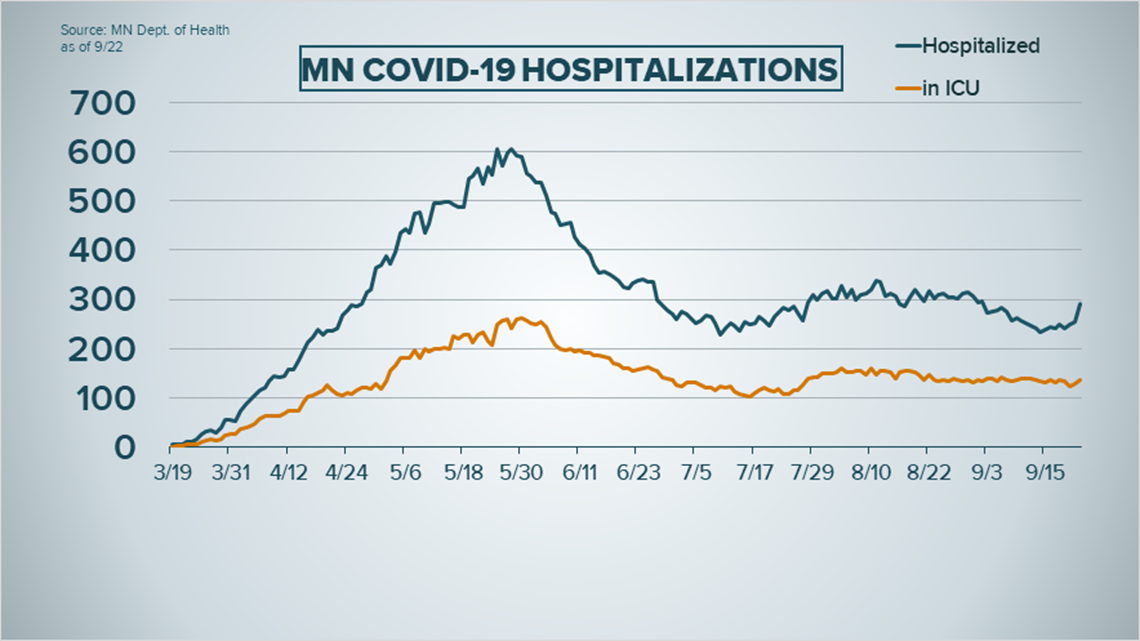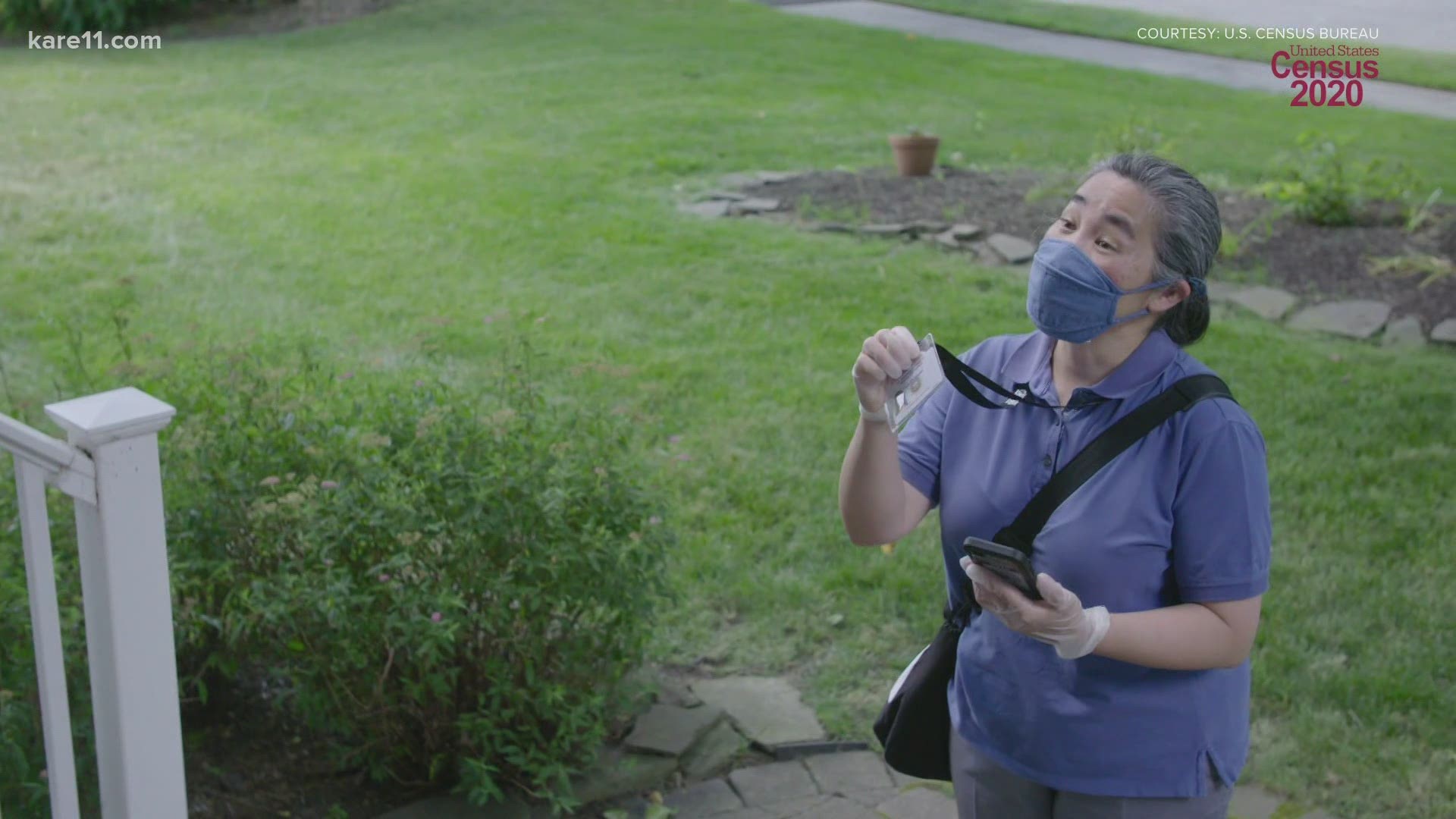ST PAUL, Minn. — Tuesday, Sept. 22
- New cases drop to 513, deaths and hospitalizations up
- MSHSL moves football, volleyball back to fall
- MDH doing free testing in Grand Rapids, Pine City and Waseca starting Sept. 21
- Five more counties show case rates high enough for 'full distance learning' recommendation
New cases of COVID-19 are down, but both deaths and hospitalizations jumped, according to numbers released by the Minnesota Department of Health (MDH) Tuesday.
Ten Minnesotans died of coronavirus in the most recent 24-hour reporting period, pushing total fatalities in the state to 1,979 since the onset of the pandemic. Of those deaths 1,430, or 72% of them, occurred in assisted living or long-term care settings.
MDH reported 513 new cases of the virus, pushing to 91,422 the number of state residents who have tested positive. Those new cases are based on the results of 9,415 tests performed in private labs and reported in the past day, a relatively low volume.
Currently there are 290 people being treated for coronavirus in Minnesota hospitals, 136 of them with symptoms serious enough to require treatment in the ICU. Health officials say 82,833 people who at one time tested positive for the virus have now recovered enough to no longer require isolation.


People between the ages of 20 and 24 make up Minnesota's largest grouping of COVID cases with 12,569 cases and a single death, followed by those 25 to 29 with 9,046 cases and three deaths. The age group between 15 and 19 accounts for 8,676 cases and zero deaths.
The largest number of deaths involve people between the ages of 85 and 89. That demographic has recorded 337 deaths in just 1,228 cases, meaning 27% of those diagnosed with COVID-19 have perished from it.
Hennepin County has the most coronavirus activity in the state with 26,147 cases and 923 deaths, followed by Ramsey County with 10,595 cases and 318 fatalities. Dakota Country reports 7,250 cases and 125 deaths since the pandemic began.
Cook County in northeastern Minnesota has the least COVID activity with just six confirmed cases, none of them fatal.
Monday, Sept. 21
2 p.m.
On a regular briefing call with reporters Monday, Minnesota Department of Health (MDH) officials addressed the highest single-day COVID-19 case count yet in the state.
Commissioner Jan Malcolm said that Sunday's 1,318 newly confirmed cases are a "new one-day record by a significant margin."
MDH Infectious Disease Director, Kris Ehresmann, added that Sunday's number was not influenced by any backlog in testing data.
"It's not a record that we're pleased about," she said.
Ehresmann said health officials believe the return to school for both K-12 and higher education are partly to blame, along with other activities and events.
She also addressed an "apparent reluctance" of people who have tested positive, or have had contact with someone who has COVID-19, to share key information with contact tracers from the state.
"While this may be tempting in the short term, it actually makes it harder for all Minnesotans," Ehresmann said.
Dan Huff, the assistant commissioner for MDH, joined the briefing call Monday to announce that the state's first COVID-19 saliva testing site in Minnesota is opening Sept. 23 in Duluth. The semi-permanent site at the Duluth Entertainment Convention Center (DECC) is the first of 10 that will be established across the state.
When asked about the MSHSL's decision to go on with high school football and volleyball this fall, Malcolm said she respected the league's decision, but did say it comes with a risk.
"All along we've sort of acknowledged that balancing these various perspectives and factors is a challenge," Malcolm said. "But from a pure, kind of public health risk protection perspective, you might say, 'Well, we know there's a lot of viral activity in the community. It's at a high enough level that we would prefer not to have events that would just gather more people and create more opportunity for transmission.'
"However, we know outdoor environments are safer and we certainly know how important these activities are to the student-athletes, to their families and to the community. We think that it's a risk calculation and there are certainly trade-offs – risks and benefits."
Malcolm said there's no way to predict what the risk level would be like in March, so couldn't say whether it would be safer had the MSHSL decided to have football and volleyball in the spring instead of the fall.
"We certainly hope (the risk) is less (in March) for a whole bunch of reasons, but there's just so much unknown about the further trajectory of the virus, some of the reinfection potential and the co-occurrence with influenza," Malcolm said. "We can appreciate that March didn't necessarily seem like a safer bet for this decision."
11 a.m.
Numbers released Monday by the Minnesota Department of Health (MDH) show 937 new cases of COVID-19 in the state.
Those new cases are based on the results of 16,938 tests processed in private and state labs in the last 24-hour reporting period. While still high, the 937 cases are actually down from Sunday, when MDH reported 1,318 newly diagnosed cases.
Four more Minnesotans have died of coronavirus, bring total fatalities to 1,969 since the start of the pandemic. Of those deaths 1,425, or 72% of them happened in long-term care or assisted living settings.
As of Monday 255 people are being treated for COVID-19 in hospitals across Minnesota, 128 of them with symptoms serious enough to require care in the ICU. MDH says 82,174 people who at one time tested positive for the virus have recovered to the point they no longer require isolation.
People between the ages of 20 and 24 make up the largest grouping of Minnesota's coronavirus cases by a significant margin with 12,509 cases and one fatality. Those between 25 and 29 account for 8,989 cases and three deaths, followed by people from 15 to 19 with 8,618 and zero fatalities.
The largest number of deaths involves Minnesota residents between 85 and 89, with 335 fatalities out of just 1,224 cases. That means 27% of people in that demographic who were diagnosed with the virus died from it.
Hennepin County has the most COVID activity of any county in the state with 26,054 cases and 922 deaths, followed by Ramsey County with 10,572 cases and 318 fatalities. Dakota County reports 7,216 cases and 125 deaths.
Cook County in far northeast Minnesota has seen the least coronavirus activity with just six confirmed cases and no deaths.
KARE 11’s coverage of the coronavirus is rooted in Facts, not Fear. Visit kare11.com/coronavirus for comprehensive coverage, find out what you need to know about the Midwest specifically, learn more about the symptoms, and see what businesses are open as the state slowly lifts restrictions. Have a question? Text it to us at 763-797-7215. And get the latest coronavirus updates sent right to your inbox every morning. Subscribe to the KARE 11 Sunrise newsletter here. Help local families in need: www.kare11.com/give11.
The state of Minnesota has set up a data portal online at mn.gov/covid19.

